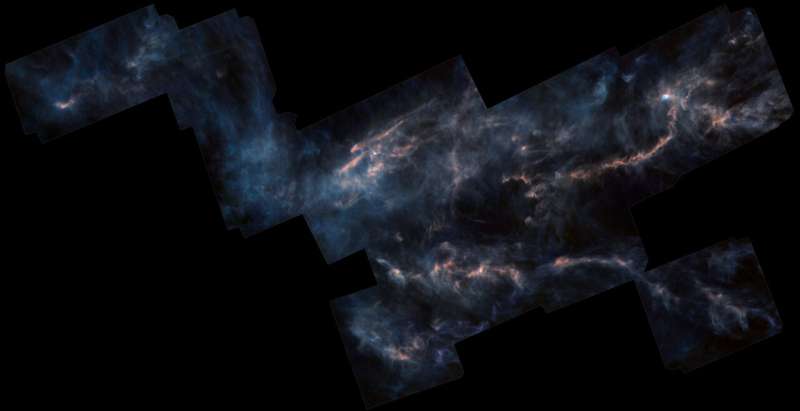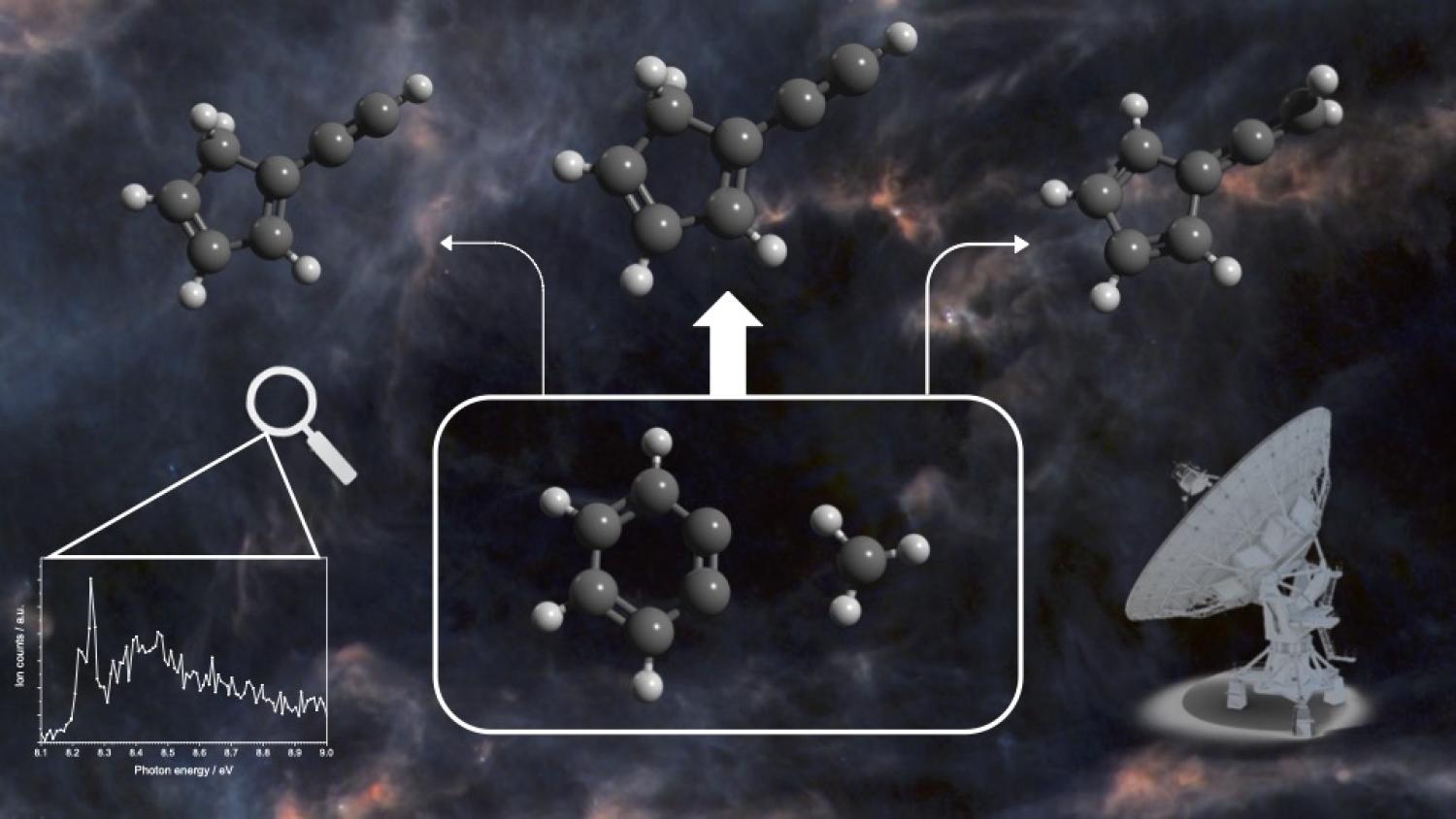What might be a crucial stage in the chemical genesis of molecules in cosmic “stellar nurseries” has been discovered by an international team of researchers. Trillions of molecules have been swirling together for millions of years in these enormous clouds of frigid gas and dust in space. Young stars and planets are eventually created when these intergalactic clouds collapse.
Like human bodies, stellar nurseries contain a lot of organic molecules, which are made up mostly of carbon and hydrogen atoms. The group’s results, published Feb. 6 in the journal Nature Astronomy, reveal how certain large organic molecules may form inside these clouds. It’s one tiny step in the eons-long chemical journey that carbon atoms undergo—forming in the hearts of dying stars, then becoming part of planets, living organisms on Earth and perhaps beyond.

This mosaic combines several observations of the Taurus Molecular Cloud performed by ESA’s Herschel observatory. Located about 450 light-years from us, in the constellation Taurus, the Bull, this vast complex of interstellar clouds is where a myriad of stars are being born, and is the closest large region of star formation. Credit: ESA/Herschel/NASA/JPL-Caltech; acknowledgement: R. Hurt (JPL-Caltech),CC BY-SA 3.0 IGO
“In these cold molecular clouds, you’re creating the first building blocks that will, in the end, form stars and planets,” said Jordy Bouwman, research associate at the Laboratory for Atmospheric and Space Physics (LASP) and assistant professor in the Department of Chemistry at the University of Colorado Boulder.
For the new study, Bouwman and his colleagues took a deep dive into one stellar nursery in particular: the Taurus Molecular Cloud (TMC-1). This region sits in the constellation Taurus and is roughly 440 light years (more than 2 quadrillion miles) from Earth. This chemically complex environment is an example of what astronomers call an “accreting starless core.” Its cloud has begun to collapse, but scientists haven’t yet detected embryonic stars emerging inside it.
The team’s findings hinge on a deceptively simple molecule called ortho-benzyne. Drawing on experiments on Earth and computer simulations, the researchers showed that this molecule can readily combine with others in space to form a wide range of larger organic molecules.
Small building blocks, in other words, become big building blocks.
And, Bouwman said, those reactions could be a sign that stellar nurseries are a lot more interesting than scientists give them credit for.
“We’re only at the start of truly understanding how we go from these small building blocks to larger molecules,” he said. “I think we’ll find that this chemistry is so much more complex than we thought, even at the earliest stages of star formation.”
Fateful observation
Bouwman is a cosmochemist, studying a field that blends chemistry and astronomy to understand the churning chemical reactions that happen deep in space.
On the surface, he said, cold molecular clouds might not seem like a hotbed of chemical activity. As their name suggests, these galactic primordial soups tend to be frigid, often hovering around -263 degrees Celsius (about -440 degrees Fahrenheit), just 10 degrees above absolute zero. Most reactions need at least a little bit of heat to get a kick-start.

But cold or not, complex chemistry seems to be happening in stellar nurseries. TMC-1, in particular, contains surprising concentrations of relatively large organic molecules with names like fulvenallene and 1- and 2-ethynylcyclopentadiene. Chemists call them “five-membered ring compounds” because they each contain a ring of carbon atoms shaped like a pentagon.
“Researchers kept detecting these molecules in TMC-1, but their origin was unclear,” Bouwman said.
Now, he and his colleagues think they have an answer.
In 2021, researchers using the Yebes 40-meter Radiotelescope in Spain found an unexpected molecule hiding in the clouds of gas of TMC-1: ortho-benzyne. Bouwman explained that this small molecule, made up of a ring of six carbon atoms with four hydrogens, is one of the extroverts of the chemistry world. It easily interacts with a number of other molecules and doesn’t require a lot of heat to do so.
“There’s no barrier to reaction,” Bouwman said. “That means that it has the potential to drive complex chemistry in cold environments.”
Identifying the culprit
To find out what kind of complex chemistry was happening in TMC-1, Bouwman and his colleagues—who hail from the United States, Germany, the Netherlands and Switzerland—turned to a technique called “photoelectron photoion coincidence spectroscopy.” The team used light generated by a giant facility called a synchrotron light source to identify the products of chemical reactions. They saw that ortho-benzyne and methyl radicals, another common constituent of molecular clouds, readily combine to form larger and more complex organic compounds.
“We knew we were onto something good,” Bouwman said.
The team then drew on computer models to explore the role of ortho-benzyne in a stellar nursery spread out over several light years deep in space. The results were promising: The models generated clouds of gas containing roughly the same mix of organic molecules that astronomers had observed in TMC-1 using telescopes.
Ortho-benzyne, in other words, seems to be a prime candidate for driving the gas-phase organic chemistry that occurs within these stellar nurseries, Bouwman said.
He added that scientists still have a lot of work to do to fully understand all the reactions happening in TMC-1. He wants to examine, for example, how organic molecules in space also pick up nitrogen atoms—key components of the DNA and amino acids of living organisms on Earth.
“Our findings may just change the view on what ingredients we have in the first place to form new stars and new planets,” Bouwman said.
Co-authors on the new paper include researchers at Leiden University in the Netherlands, Benedictine College in the U.S., the University of Würzburg in Germany and Paul Scherrer Institute in Switzerland.
Source: phys.org







